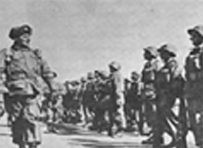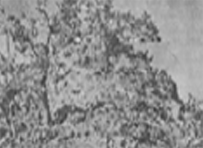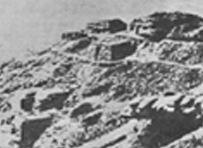
the U.S. Presidential Medal
Battle near Twin Tunnels (25km Northwest of Wonju; 1951. 1. 31~2. 2)
This was the battle in which the French Battalion fought against the Chinese Communist 125th Division near the Twin Tunnels on the Central Railroad between Wonju and Yangpyeong. When the 1st Battalion and the 2nd Battalion Reconnaissance Unit of the U.S. 23rd Regiment were patrolling from Wonju to Jipyeong-ri during the U.N. Forces' Counteroffensive, they were surrounded by the Chinese Communist Army near the Twin Tunnels located in the middle of these two locations.
This Battalion along with the 3rd Battalion of the U.S. 23rd Regiment advanced to the battle area on Jan. 31 to defeat the Chinese Communist Army and rescue the Reconnaissance Unit.
The French Battalion in cooperation with the U.S. Battalion moved to the Twin tunnels area but the Chinese Communist Army already left the area.
After rescuing the Reconnaissance unit, they therefore began guarding all directions to prepare for a night battle. At the dawn of the next day, 2 regiments under the command of the Chinese Communist 125th Division attacked them.
The Chinese Communist Army destroyed 1 French company position and threatened the Battalion Headquarters, but the French Battalion fought bravely to defeat the Chinese Communist Armys attack.
The French Battalion caused the Chinese Communist Army heavy casualties in this battle and opened up the road for the U.N. Forces' attack units.
Battle of Jipyeong-ri
This was the battle in which the French Battalion attached to the 23rd Regiment of the U.S. 2nd Division defended an intensive attack by 3 enemy divisions under the command of the Chinese Communist 39th Army Corps at Jipyeong-ri during the Chinese Communist February Offensive in Feb. 1951.
After completing the Twin Tunnels battle, this Battalion along with the Regiment moved to Jipyeong-ri on Feb. 3 and defended the west flank of the defensive position formed around Jipyeong-ri.
The adjacent units on both flanks retreated due to the Chinese Communist February Offensive on Feb. 11, the U.S. 23rd Regiment and French Battalion were surrounded by the Chinese Communist 39th Army Corps in all directions.
But the order was passed down to defend the position because of the importance of the terrain and they defeated the Chinese Communist series of attacks in isolation for 4 days to secure the position.
The Chinese Communist Army retreated on Feb. 16 when the U.S. 5th Cavalry Regiment arrived in Jipyeong-ri from their rear side. As a result of this battle, the Chinese Communist Army suffered heavy loss and their February Offensive failed.
The U.N. Forces were able to change the course of the war to prepare a plan for a counteroffensive for the first time since the Chinese Communist intervention.

Battle of Heartbreak Ridge (22km North of Yanggu ; 1951. 9. 13~10. 13, Hill 894-931-851)
This was the battle in which the French Battalion along with the U.S. 23rd Regiment and the Netherlands Battalion fought fiercely with the North Korean Army (the 6th and 12th Division) in the Yanggu-gun Dong-myeon Satae-ri area.
When the discussion of the cease-fire talk on Jul. 10, 1951 collapsed because the Communist side intentionally delayed the talk, the U.N. Forces urged the Communist side to respond to the talk and at the same time carried out this battle to establish the defense line at a more favorable location.
The French Battalion along with the U.S. 23rd Regiment with the support of the Division began attacking Heartbreak Ridge from Sep. 13 but failed to capture it due to the North Korean Army's stiff resistance. Later, all units in the Division were dispatched and the ridge was captured.
The U.S. 38th Regiment and 72nd Tank Battalion attacked the Mundeung-ri Valley, the west of Heartbreak Bridge, and the U.S. 23rd Regiment and French Battalion along with Special Task Force consisted of the 23rd Tank Battalion attacked Heartbreak Ridge from the Satae-ri Valley, the east of Heartbreak Ridge.
And, the 9th Regiment launched an attack simultaneously from the west of the Mundeung-ri valley.
In this battle, the French Battalion suffered heavy due to the Communist Army's stiff resistance and caused the Communist Army immense damage too.
The cease-fire talk resumed 9 days after this battle ended.
caution When UPI's war correspondent Stan Carter visited the U.S. 2nd Division Battalion medical treatment facility during this battle, a wounded soldier was yelling in anguish "feels like my chest is torn apart" while shivering. After he witnessed this scene, he described the battle condition as "Heartbreak Ridge" when reporting about this battle. Thereafter, Hill 929 was known as the Heartbreak Ridge.

the U.S. Presidential Medal
Battle of Arrowhead Hill (1952. 10. 6~10)
This was the battle in which the French Battalion fought against the 338th Regiment of the Chinese Communist Army 113th Division while defending Hill 281, northwest of Cheolwon. The Chinese Communist Army dispatched a battalion or company size unit every night from Oct. 6 to Oct. 9 to attack Hill 281, but this Battalion defended the position using close-range combat tactics with artillery support.
At the same time, the South Korean Army 9th Division was fighting against the Chinese Communist Army on their right side at the Baekma Hill.
As this Battalion defended the hill until the end, they were able to subdue the Chinese Communist Army's morale and make a big contribution to the defense of the Baekma Hill located on their right side.
After the cease-fire agreement, most of the French Force left from Oct. 23 to Nov. 6 in 1953 except for a small size unit that remained.
The remaining unit left in Jun. 1964.
